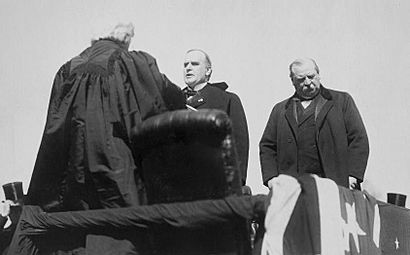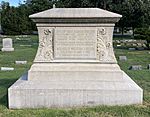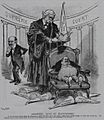Melville Fuller facts for kids
Quick facts for kids
Melville Fuller
|
|
|---|---|

Fuller in 1908
|
|
| 8th Chief Justice of the United States | |
| In office October 8, 1888 – July 4, 1910 |
|
| Nominated by | Grover Cleveland |
| Preceded by | Morrison Waite |
| Succeeded by | Edward Douglass White |
| Personal details | |
| Born |
Melville Weston Fuller
February 11, 1833 Augusta, Maine, U.S. |
| Died | July 4, 1910 (aged 77) Sorrento, Maine, U.S. |
| Resting place | Graceland Cemetery, Chicago, Illinois, U.S. |
| Political party | Democratic |
| Spouses |
|
| Children | 10 |
| Education | Bowdoin College Harvard University |
| Signature | |
Melville Weston Fuller (February 11, 1833 – July 4, 1910) was an American lawyer and judge. He served as the eighth Chief Justice of the United States from 1888 until his death in 1910. The Chief Justice leads the Supreme Court, the highest court in the U.S.
Fuller was known for his conservative views. He often supported free enterprise (businesses operating without much government control). He also believed in limiting the power of the federal government. He wrote important opinions on topics like the federal income tax and citizenship. He was also part of major decisions about racial segregation. Many of his rulings were later criticized and some were even changed by later court decisions.
Born in Augusta, Maine, Fuller became a lawyer in Chicago. He was a member of the Democratic Party and was active in politics. He supported Stephen A. Douglas in the 1860 presidential election. During the Civil War, he served in the Illinois House of Representatives. There, he disagreed with President Abraham Lincoln's policies.
President Grover Cleveland nominated Fuller to be Chief Justice. Fuller was confirmed by the Senate in 1888. He was known for being friendly and good at managing the Court. Many of his decisions, especially those about economic freedom and racial segregation, were later overturned. His legacy is still debated today.
Contents
Early Life and Education
Melville Weston Fuller was born on February 11, 1833, in Augusta, Maine. His family had a strong legal background. His grandfather on his mother's side was a judge on the Supreme Judicial Court of Maine. His grandfather on his father's side was also a judge.
Fuller went to Bowdoin College and graduated in 1853. He then studied law in an uncle's office. He also spent six months at Harvard Law School. This made him the first Chief Justice to have formal legal training from a university. Fuller became a lawyer in Maine in 1855. He later worked as an editor for a Democratic newspaper. He also served as a city official in Augusta.
Early Career and Politics
In 1856, Fuller moved to Chicago, Illinois. He saw more opportunities there as a Democrat. He became a lawyer and got involved in politics. Fuller was against slavery, but he believed each state should decide on the issue, not the federal government. He supported the Kansas–Nebraska Act, which allowed new territories to choose if they would allow slavery. He wanted compromise instead of conflict.
Fuller supported Stephen A. Douglas in his campaigns against Abraham Lincoln. When the American Civil War began in 1861, Fuller supported fighting to keep the country united. However, he disagreed with President Lincoln's actions during the war. He felt many of Lincoln's decisions were against the Constitution.
In 1862, Fuller was elected to the Illinois House of Representatives. He spoke against the Emancipation Proclamation, which freed enslaved people in Confederate states. He believed it went against states' rights. He also opposed Lincoln's decision to suspend habeas corpus, which protects people from being held without charge. Fuller never sought legislative office again after this term.

Fuller built a very successful law practice in Chicago. He represented many large companies and business owners. He argued cases before the Supreme Court of the United States. He became one of Chicago's highest-paid lawyers.
He remained active in the Democratic Party. He attended several national conventions. Fuller believed in a strict interpretation of the Constitution. This means he thought the government should only do what the Constitution clearly says it can do. He supported states' rights and limited government. Fuller was a strong supporter of President Grover Cleveland. Cleveland offered Fuller several government jobs, but Fuller turned them down.
Becoming Chief Justice
In 1888, Chief Justice Morrison Waite passed away. President Cleveland needed to choose a new Chief Justice. Cleveland wanted someone who was not too old and could get support from both Democrats and Republicans in the Senate. He decided to choose someone from Illinois.
Cleveland offered the job to another judge first, but he declined. Fuller's friends encouraged the President to consider him. Fuller was 55 years old, a good age for the position. Cleveland liked his reputation and his political views. Fuller accepted the nomination, though he was hesitant at first. He was officially nominated on April 30, 1888.
The public had mixed reactions to Fuller's nomination. Some newspapers praised him, while others said he was not well-known enough. Republicans in the Senate criticized Fuller because he had opposed Lincoln's policies during the Civil War. They called him an "anti-war Northern Democrat." However, some Republicans defended him, saying his actions were not disloyal.
The Senate Judiciary Committee, which reviews nominations, delayed voting on Fuller. Eventually, the full Senate voted on July 20. After much debate, Fuller was confirmed by a vote of 41 to 20. Ten Republicans joined the Democrats in supporting him. Fuller officially became Chief Justice on October 8, 1888.
Leading the Supreme Court

Melville Fuller served as Chief Justice for 22 years, until his death in 1910. He was a skilled manager of the Court. He encouraged the justices to shake hands before their private meetings to promote teamwork. He generally kept good relationships among the justices, even though they sometimes had strong disagreements.
Fuller was the first Chief Justice to directly ask Congress for new laws. He successfully pushed for the Circuit Courts of Appeals Act of 1891. This law created new appeals courts, which helped reduce the Supreme Court's heavy workload. This allowed the Supreme Court to decide cases more quickly.
As Chief Justice, Fuller decided which justice would write the main opinion for most cases. He often gave important cases to other justices and kept less exciting ones for himself. His writing style was seen as straightforward and detailed.
In 1893, President Cleveland offered Fuller the job of Secretary of State. Fuller turned it down. He said he enjoyed being Chief Justice and that taking a political job would hurt the Supreme Court's reputation for being fair. He also served on international commissions to settle disputes between countries.
Fuller's health declined after 1900. He passed away in July 1910. Associate Justice Edward Douglass White was chosen to replace him.
Important Court Decisions
Fuller's time on the Supreme Court was marked by several important decisions. His legal philosophy focused on states' rights, limited federal power, and economic freedom.
- In Pollock v. Farmers' Loan & Trust Co. (1895), Fuller wrote the majority opinion. The Court ruled that a federal income tax was unconstitutional. This decision was later changed by the Sixteenth Amendment, which allowed the government to collect income taxes.
- In United States v. E. C. Knight Co. (1895), Fuller's opinion limited Congress's power to control trade between states. This made it harder for the government to stop monopolies (when one company controls an entire industry).
- In Lochner v. New York (1905), Fuller agreed with the majority. The Court said that states could not limit the working hours of businesses. They believed it interfered with a person's freedom to control their property and business.
- Fuller joined the majority in Plessy v. Ferguson (1896). This case said that "separate but equal" facilities for different races were legal. This ruling supported Jim Crow laws, which enforced racial segregation. This decision was later overturned in Brown v. Board of Education (1954).
- In the Insular Cases, Fuller believed that people living in U.S. territories should have the same constitutional rights as other Americans.
- He disagreed with the majority in United States v. Wong Kim Ark (1898). In that case, the Court ruled that people born in the U.S. are citizens, no matter their parents' nationality.
Personal Life
Melville Fuller was married twice. His first wife, Calista Reynolds, passed away in 1864. They had two children. He then married Mary Ellen Coolbaugh in 1866. They had eight more children. Mary Ellen passed away in 1904.
Fuller enjoyed poetry and literature. He had a large personal library with over six thousand books. He was also a member of the Chicago Literary Club.
During his confirmation as Chief Justice, Fuller's mustache became a topic of discussion. No Chief Justice had ever had a mustache before! Newspapers debated whether it was proper for a Chief Justice. Some praised it, while others joked about it. Despite the comments, Fuller kept his mustache.
Death
Melville Fuller passed away on July 4, 1910, at his summer home in Sorrento, Maine. He died from a heart attack.
President William Howard Taft praised Fuller as "a great judge." Former President Theodore Roosevelt also spoke highly of him. Fuller was buried at Graceland Cemetery in Chicago.
Legacy and Statue
Fuller's time on the Supreme Court has often been criticized. His support for the Plessy v. Ferguson decision, which allowed racial segregation, is a major reason for this. Many of the decisions made by the Fuller Court were later overturned. Some scholars believe his Court favored large corporations and the wealthy.
However, some people have started to view Fuller more positively. They argue that his decisions fit with the common beliefs of his time. Others still believe that the Court should have stood up against popular opinion when it came to important rights.
In 2013, a statue of Fuller was placed in front of the Kennebec County Courthouse in Augusta, Maine. Because of the Plessy v. Ferguson decision, there was a debate about whether the statue should remain. In 2021, the county commissioners voted to remove the statue from public land. They wanted to show that the county did not support racial segregation. The statue was removed in February 2022 and placed in storage.
Images for kids
See also
- Fuller Park, a neighborhood in Chicago named after him.
- Fuller-Weston House, a historic home in Augusta, Maine, where Fuller lived.






